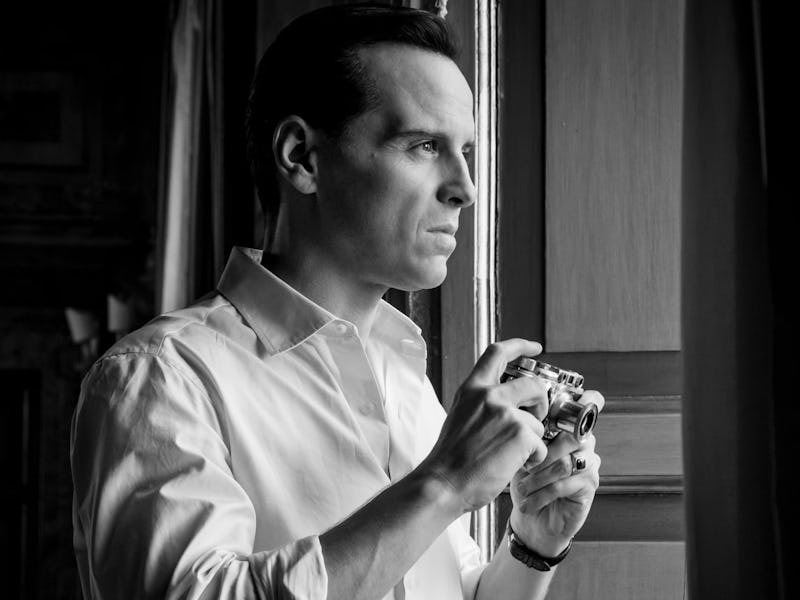How Ripley Breaks Modern TV Rules
Steven Zaillian's masterful Netflix thriller doesn't even need dialogue.

Ripley isn't like anything else that's on TV right now. The Netflix series is, for starters, shot entirely in black and white by cinematographer Robert Elswit. That decision alone, which brings the noir aspects of Ripley's story and setting front and center, separates it from every other prestige TV drama in recent memory. Some viewers have inevitably taken issue with the show's monochromatic look, too, it only makes watching the series and all of its elliptical cutting patterns an even more hypnotic experience.
It also reinforces the fact that Ripley is, among other things, an immensely visual show. It doesn't just encourage viewer engagement, it demands that one gives it their full, undivided attention. The series doesn't just do that by delivering more beautiful images in a single episode than most TV shows produce over entire seasons, but by filling its eight-hour runtime with long, dialogue-free scenes and sequences. Indeed, of all of the many surprising tricks that Ripley has hidden up its sleeves, not a single one is more effective or refreshing than its belief in the power of silence.
Andrew Scott gives a spell-binding, frequently silent performance in Netflix’s Ripley.
Television has never been a medium known specifically for its visual storytelling. For several decades, most TV seasons demanded that too many episodes be produced in too short a period of time for shows to maintain identifiable or particularly artistic visual styles. The medium's signature ongoing, episodic structure has also resulted in many series relying more on plot than most two-hour movies do, which is something that dialogue is often used to explain, set up, and move along. TV has, of course, grown into an increasingly prestige, complex, and diverse medium over the past 20 years, but it's still seen by many as a less visual format than cinema.
Ripley, however, challenges that perception. Not only does it boast a visual style that is as distinct as it is striking, but one could arguably watch it with the sound off and — assuming they have a basic understanding of its premise — still keep up fairly easily with its story. It relies less on dialogue than your average TV show and lets many of its biggest moments unfold completely silently, whether it be Tom Ripley's (Andrew Scott) murder of Dickie Greenleaf (Johnny Flynn) in its third episode or his attempts to cover up his killing of Freddie Miles (Eliot Sumner) in its standout fifth installment. There are sections of Ripley that feature no dialogue and just follow Scott's Tom as he schemes and tries to move throughout the show's midcentury European world.
There aren't many TV protagonists as complex as Tom Ripley, but you don't get a sense of who the character truly is in Ripley through what he says. The show offers a window into its lead's mind not through his words but through his actions. It's the way he longingly looks at Dickie and Marge Sherwood (Dakota Fanning) with so much envy when they don't know he's around that tells you everything you need to know about Tom, and the same goes for how obsessively he cleans up his apartment after he murders Freddie. Ripley doesn't feed its emotions or even its moments of tension to you through its dialogue. It does so through its images and editing, and that means you don't have nearly as much freedom to look away from it as you do in most shows.
Ripley is an example of visual storytelling at its finest.
Beyond how brilliantly Ripley uses Andrew Scott's face and Robert Elswit's cinematography to push its plot forward, many of the show's best jokes are also entirely visual. Look, for instance, at how it communicates the frustrating, circular nature of Tom's efforts throughout one night to restage Freddie's death as the result of a simple robbery gone wrong. The series, which was written and directed solely by series creator Steven Zaillian, reuses the same cutting pattern to show Tom making the same journey across Rome multiple times, and what begins as another methodical illustration of his obsessiveness becomes a darkly funny portrait of his intense, undying paranoia.
Few TV shows could achieve that effect purely through their images, but Ripley can. The fact that it does so effortlessly is not only a testament to its strengths as a piece of visual storytelling, but also yet another reason why it deserves your complete attention. It's been a long time since a show like Ripley has premiered, and it'll be a while before anything like it comes along again.